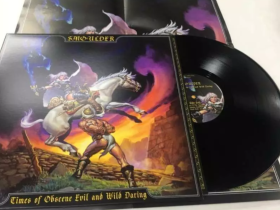(TheBRHM.com) Southern soul is a genre I’ve always enjoyed. A marriage of blues, country, Black gospel music, and R&B of the time. It was a mix of things that made a very district sound in the South among Black musicians and audiences during the 1960s and into the 1980s.
That isn’t to say that the genre is done or died out. There are veterans touring from the aforementioned periods and a few younger acts who even keep up the sound of 1980s. So, what makes this strain of blues so interesting to me?

The Sound
I’m a history guy. I enjoy the history of whatever and will read issues or comics going back decades with a series or start a musician’s discography from the beginning. That’s something I’ve always felt was important. Whenever music fans get into a new artist, it’s not unusual to listen to that artist from the release they discovered the artist from and beyond.
The stuff that brought to the dance—all of those demos, mixed tapes, and previous albums—might not get a listen from recent fans. So, I always dive into older albums and will end behind by two recent releases as was the case with one of my favorite metal bands Darkthrone.
In the case of Southern Soul, I enjoy the stuff from the 1960s and early 1970s but the stuff from the late 1970s and the 1980s is my favorite. It also shows how in a subgenre, the sound can change distinctly within a decade.
The 1960s-1970s stuff was very rooted in blues and gospel—almost to the point where it could be a larger regional subgenre, really. However, as the 1970s rolled on, music across the board built on different sounds and new genres were formed while older ones modernized.
With the second act of southern soul, you had the roots of blues with more of an influence from soul, disco and R&B. It wasn’t exactly poppish but it did have more of a bounce and swagger or strut to it. Some artists like James Brown, Marvin Sease, Millie Jackson, and Peggy Scott Adams added energy and excitement to the sound and performances.
That isn’t to say that these were present in the first wave or first act. Sonically, there were a lot of flavors there because there were a lot of genres that cropped up in that period. Funk, disco, go-go, P-Funk, psychedelic, rock, outlaw country, metal, hip hop punk—those 1960s and 1970s decades were very busy for music.
The Storytelling of Southern Soul
As you may have gathered, I dig music with a quicker tempo and Southern soul can vary in tempo from energetic songs with a bounce to slower tunes. However, I’ve always loved storytelling in music and I also enjoy southern storytelling.
I’m a Southerner, I love to hear my regional family tell a story with all of the humor and embellishment. You totally get that flavor in the storytelling and songwriting in southern soul just as you would in any blues derivative. It’s all in how the story is told and what the story is. It’s similar to enjoying different kinds of hip-hop by region, honestly. Sometimes the region can impact the lyrical content itself since the story is being told from the artist’s perspective and might include their experiences.
In another entry, we’ll get into one of my favorite characters who embraces the sleazy, trickster approach to some of southern soul’s iconic tunes and themes—romance and salacious relationships. I’m talking about Marvin Sease and his persona of Mr. Jody.
Now, there are many other artists in this genre who explored cheating, struggling to stay, being cheated on, and everything in that pot. Songs have been covered by contemporaries and peers. However, Marvin Sease’s storytelling really caught me.
If you’re a fan of blues or southern soul, let us know your favorite period and some of your favorite artists!
Staff Writer; M. Swift
This talented writer is also a podcast host, and comic book fan who loves all things old school. One may also find him on Twitter at; metalswift.










Leave a Reply